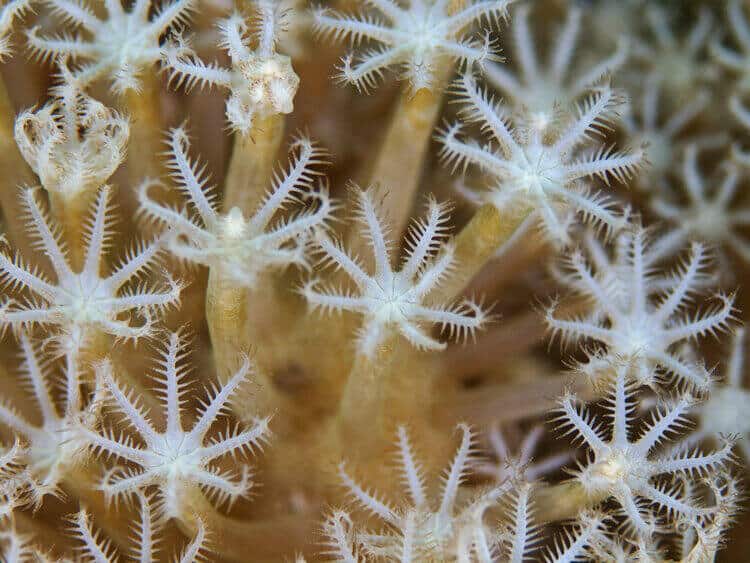
The pretty and exotic Blue Coral, Organ Pipe Coral, Green Star Polyps, and Sea Pens are some of the most unique Octocorals!
Some of the most familiar, fascinating, and unique Octocorals are the Blue Coral, Organ Pipe Coral, Green Star Polyps, and the Sea Pens. Octocorals consist of a very large number of animals that are primarily non reef-building corals belonging in the Subclass Octocorallia.
Like the name Octocoral suggests, they are described as generally having eight-fold symmetry or eight-branched tentacles in their polyp structure. There are a number of very distinct groups within the Octocoral subclass. The largest groups include many of the beginner aquarium Soft Corals and Leather Corals. Other large groups are the beautiful Gorgonians or Horn Corals, known as Sea Fans and Sea Whips.
Unique Octocorals like the Blue Coral, Organ Pipe Coral,Green Star Polyps, and the Sea Pens are relatively small groups by comparison, but are very familiar to most. They are fascinating animals that are regularly seen in public aquariums, and occasionally found in the aquarium industry.
The majority of the Octocorals consist of mostly living tissue. Rather than creating larger skeletal masses like the stony corals, they have tiny little skeletal pieces buried inside their tissue called spicules or sclerites. Although they are Octocorals, the Blue Coral and the Organ Pipe Coral are a couple of quirky exceptions. Similar to the stony corals, these are the only two Octocorals with larger calcareous structures.
The Blue Coral has a couple of additional characteristics that make it even more unique. It is the only species in its class and the only coral with a blue skeleton. Sea Pens are also unique in that they have a very long stalk anchored in soft bottoms, with some reaching up to 6 feet in height. Another unusual characteristic is that they can pick up and move. There are quite a number of corals in the Stolonifera suborder, but the Organ Pipe Coral and the Green Star Polyps are the two species that are quite well known.
The Organ Pipe Coral, like the Blue Coral, is also quite unique. It is the only other Octocoral with a hard skeletal structure. However, unlike the Blue Coral or the stony corals, its skeleton is made up of fused sclerites. It is also unique in that its skeleton is a beautiful bright or dark red.
For information about setting up a reef tank see:
Reef Tanks – Mini-Reef Aquarium Basics
Blue Coral
The Blue Coral or Blue Fire Coral Heliopora coerule, is classified in the order Helioporacea, under the family Helioporidae. It is one of only two types of Octocorals that calcify an external skeleton. The other is the Organ Pipe Coral Tubipora musica in the Tubiporidae family.
Besides a calcareous skeleton, the Blue Coral has a couple of additional characteristics that make it even more unique. It is a single species and the only member classified in the Order Helioporacea. It is also the only coral with a blue skeleton. Its name is derived from the permanently blue color of its calcareous structure.
Sea Pens
There are around 300 species of Sea Pens or Sea Pansies. They live at many depths from shallow waters down to deep seas. Sea pens can be fleshy or filamentous, and can expand to great length and size by pumping water into their gastrovascular cavities. The common name, Sea Pen, is derived from their appearance. These tall standing corals are reminiscent of a pen held upright in a penholder. The most flamboyant and decorative Sea Pens belong to the Suborder Subselliflorae. They have a feather-like appearance, resembling an old-fashioned quill pen. Other types, like the Fleshy Sea Pen Ptilosarcus gurneyi, primarily have a chunky, more club-like appearance.
Sea Pens share many characteristics with Soft Corals, but there are differences too. The biggest difference is in their habitat. While a Soft Coral will attach to hard substrates, the Sea Pens anchor themselves with their bulb-like shape into deep soft bottoms like sand or mud. They can also easily free themselves and move around.
During the daylight hours Sea Pens usually bury themselves into the sand, and emerge at night to capture plankton. Each colony is either male or female, though females are usually predominant in nature. Colors range from dark orange to yellow and white and are often bright. Many are very attractively colored due to pigmentations within their calcerous sclerites, and many will luminense in the dark.
Mat Polyps – Star Polyps
The Mat Polyps or Star Polyps consist of quite a number of families in the Suborder Stolonifera. However it is the family Tubiporidae that has the two best-known species. The Organ Pipe Coral Tubipora musica, is the other species, like the Blue Fire Coral, that calcifies an external skeleton. The Green Star Polyps Briareum (Pachyclavularia) violacea is a common favorite that is very hardy, very pretty, and thrives in the aquarium.
Tubipora colonies are massive, and formed by parallel tubes connected on horizontal platforms. These tubes are actually sclerites, like those found in other Octocorals. But on these corals the sclerites are fused to form the skeleton rather than being the calcerous skeleton found on stony corals. Tubipora colonies are found throughout the Indo-Pacific and are in common shallow coral reefs with a calmer water flow.
The Organ Pipe Coral Tubipora musica has a distinctive skeleton that is a beautiful bright or dark red color. Its beautiful skeleton is usually hidden however, when its polyps are extended.
Featured Image Credit: scubaluna, Shutterstock




